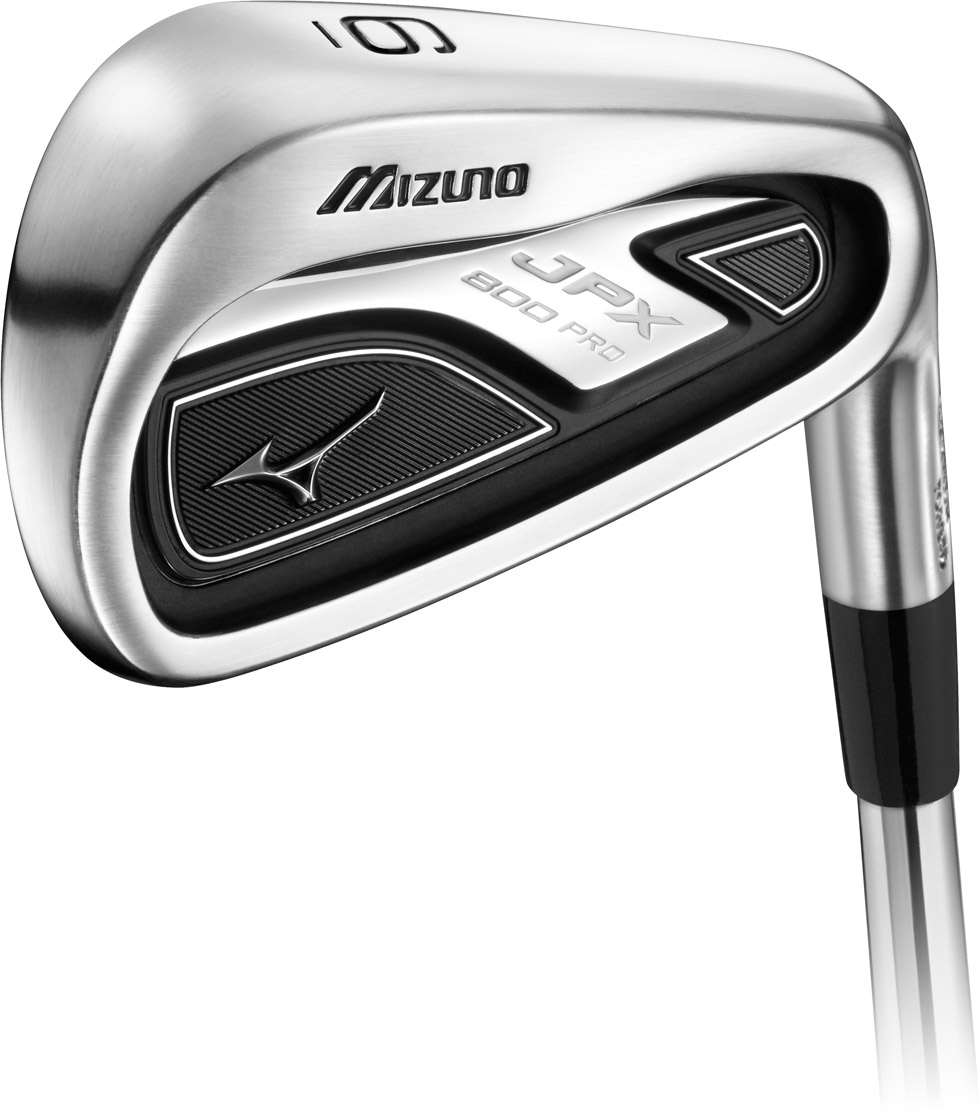 Though Mizuno said goodbye to the MX series this year, they had the new JPX series waiting in the wings to fill the game improvement gap. Of course I jumped at the opportunity to review the new JPX-800 Pro, since this new series would replace that which contained the MX-300s I loved so much.
Though Mizuno said goodbye to the MX series this year, they had the new JPX series waiting in the wings to fill the game improvement gap. Of course I jumped at the opportunity to review the new JPX-800 Pro, since this new series would replace that which contained the MX-300s I loved so much.
Though a large number of players may not have been very excited about this change, Mizuno was there to reassure everyone, saying that this was their biggest commitment to the game improvement category yet, and that the JPX series may in fact be a game changer. When a global company such as Mizuno pools all of their talented engineers from around the world, you know they really do mean business. So how did that pay off in real world results?
When writing these reviews, I don’t like to use comparison as a way of evaluating a club. The values are nearly impossible to quantify, and it’s impossible to know if the reader is familiar with the product being used as the basis for comparison. Still, with Mizuno’s new JPX-800 Pro irons, it’s nearly impossible for me NOT to subconsciously compare them with their predecessor, the MX-300s, which I reviewed last year. Since the review, that MX-300 set has been a staple in the rotation of clubs in my bag. Needless to say, it’s going to be hard to top them.
As soon as I opened the box and pulled out the first iron, my thought was that the new JPX-800 Pro came to impress.
Design
Back in October, when we covered the launch of the JPX-800 Pros (as part of the new global JPX brand), a quote by Iver Maple revealed that the new JPX series is Mizuno’s biggest commitment to the game improvement category, ever.

Like the slightly larger JPX-800, the JPX-800 Pro was designed for both distance and forgiveness, though with a smaller head and with a greater degree of control. While the previous generation MX-300 intended to blur the line between game improvement and player’s iron, it doesn’t seem that line is quite as blurry any more – these sit pretty comfortably in the GI category more than anything. Though they definitely remain at the higher end of the GI spectrum.
Though the JPX-800 Pro may be the first generation of what’s sure to be a great lineup for years to come, it certainly has its fair share of attractive technological features for being the first in its series. For starters, it has the largest sweet spot ever found in a Mizuno Grain Flow Forged iron. That means distances should be both long and consistent, even if you aren’t striking it perfectly every time. That’s not the only title it holds; the JPX-800 Pro also registers as producing the highest CoR values ever recorded with a single piece Grain Flow Forged iron. The bottom line is that the numbers don’t lie – Mizuno isn’t just giving us a bunch of marketing speak when they say these are among the longest irons they’ve ever produced.
Research and Development previously operated independently in Japan, Europe, and the United States, but for the creation of the JPX series, all of those islands of independent expertise were combined, effectively pooling all of their technological and design accomplishments. The result is exactly what you read above – extreme CoR, huge sweet spot, and explosive, consistent yardage all rolled up into an wonderfully attractive head.
Like a large number of previous Mizuno irons, they started with soft 1025 “Pure Select” mild carbon steel as the material of choice. By using a very precise CNC milling process, the face was thinned, resulting in greater flexibility in the face, and an increase in ball speed upon impact. An additional benefit comes as a result of this process – it is one of the contributing factors to locating the center of gravity low and deep, further increasing both stability and forgiveness.
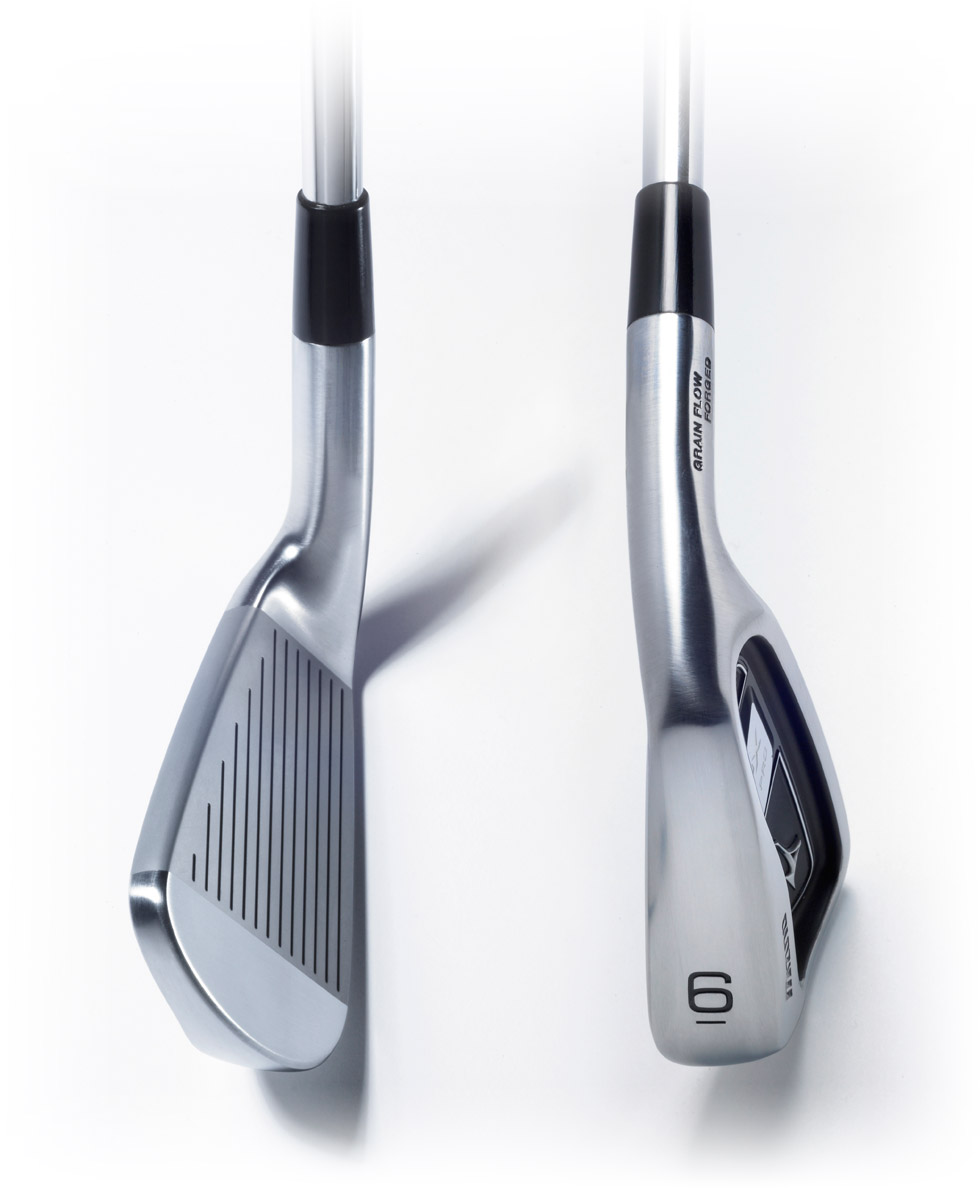
Though distance and forgiveness were key design goals/intentions, Mizuno’s engineers didn’t forget what has made them so popular – that much praised sound and feel. To achieve their high standard for these qualities, Modal Analysis and Harmonic Impact Technology was used to tune everything to perfection. As a side note, you may not be aware, but the other major contributor to the sound and feel is the Grain Flow Forging process, proving that this quality is a consideration from the very beginning.
As you can probably already tell, the JPX-800 Pro is a little smaller than the JPX-800, and is geared for the player looking for a little more control than it’s max forgiveness sibling. They were also designed with considerably less offset than the JPX-800s though just ever so slightly more than the MX-300s (though likely not discernible).
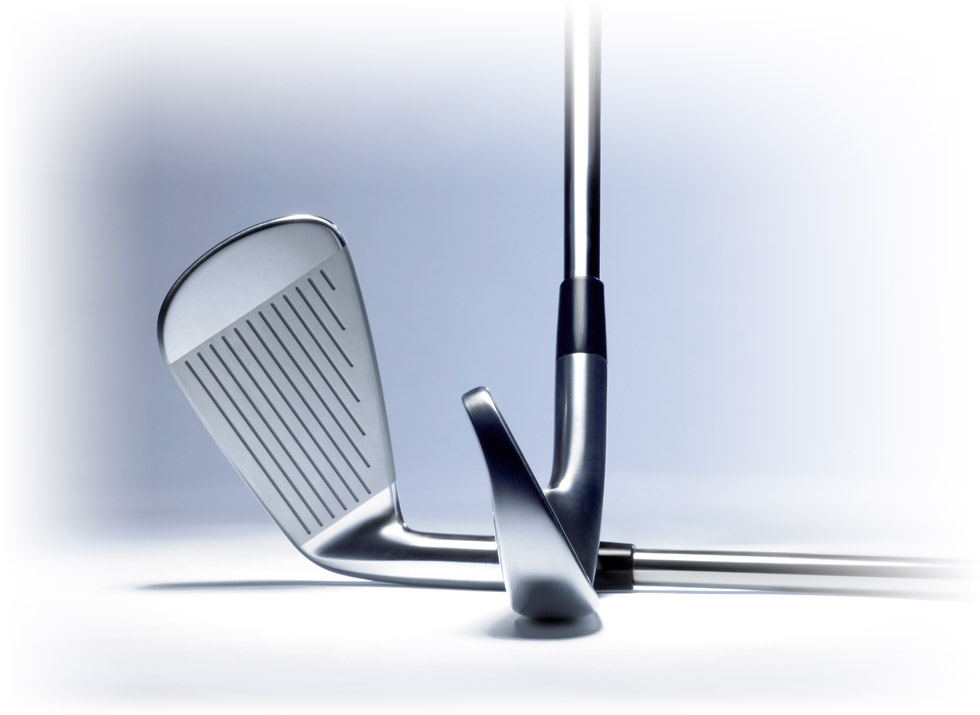
Rounding out the club head is an aggressive Triple Cut sole design, which promotes solid ball striking from all types of lies.
Esthetics
You’ve got to hand it to Mizuno, they have always done a great job at producing very clean, visually appealing clubs, especially in the game improvement category. I mean, lets be honest, it’s not hard to make a good looking blade, but nowadays, a lot of manufacturers tend to get carried away with the appearance of their GI offerings. Mizuno keeps it simple however, as the backs feature a simple black/polished steel coloring scheme. Upon closer inspection, you’ll notice tat what you’re looking at is raised badging, and appears to actually be two separate pieces. This is a sharp contrast to what existed in the MX-300, though don’t take that to mean it’s a bad quality, it’s just different. In fact, I’d definitely rank the JPX-800 Pro among the cleanest looking game improvement irons to come out this year.
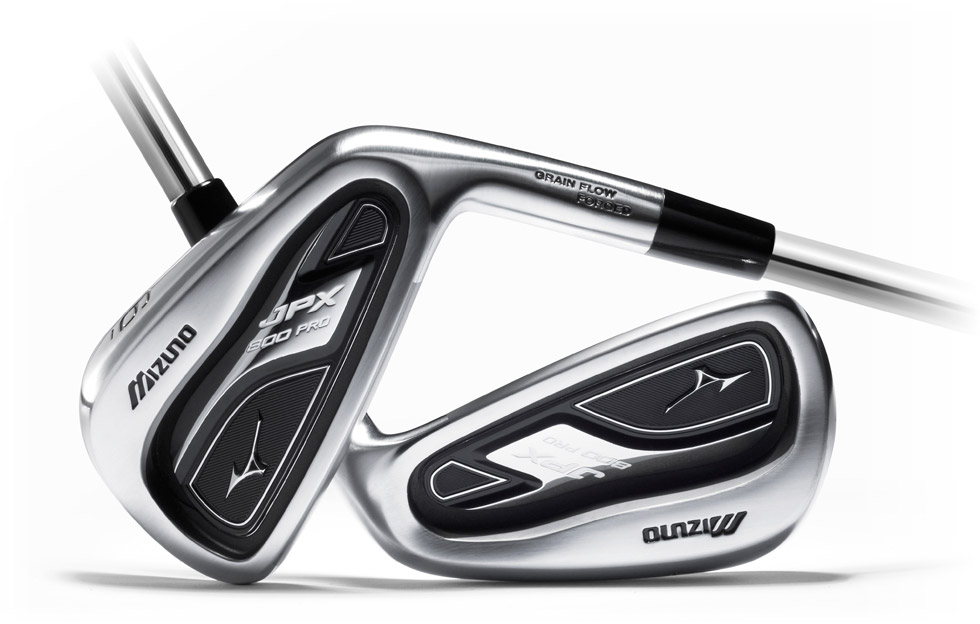
The polished “Y” section of the badge is stamped with the JPX-800 Pro name, and extends nearly from heel to toe, and turns up right behind where the sweet spot should be. Other than thin lines of polished trim, and the appearance of the Mizuno logo, the rest of the back remains devoid of any extraneous decoration. Needless to say, I’m a big fan. In person, the appearance is very clean and attractive. Overly thick, gaudy irons that try too hard drive me nuts, but that’s simply not the case here.
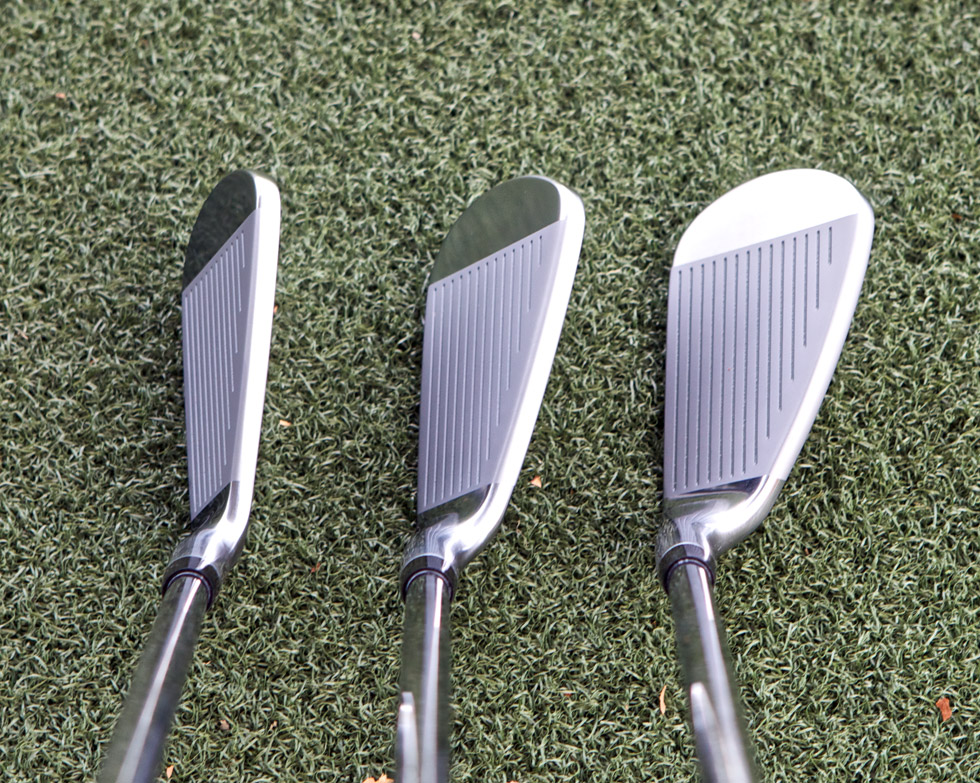
Moving down, the Mizuno stylized name is stamped slightly offset of center on the external power bar. The triple cut sole keeps it pretty simple too, as it is simply stamped with the iron number. The hosel itself is standard fare, with only the Grain Flow Forging stamping present. As a side note, when comparing side by side with the MX-300, they appear to be slightly longer from heel to toe, though the difference can’t be any more than a few millimeters. The topline, though not as thin as that found in a players’ iron, isn’t nearly as thick as lots of others in this category.
Performance
Due to some circumstances out of my control, I wasn’t able to play nearly as much as I’d like over the last few months. “Rusty” was probably the best way to describe my golf game. I know my game isn’t sharp right now, but I refuse to fall back to an iron that’s all forgiveness and no feel. Still, I want to put the clubs in the bag that will give me the best chance at playing well and having a good time. So upon receiving the JPX-800 Pros and getting my first look at them in person, I had a feeling they wouldn’t disappoint.

As it turns out, that was the correct assumption to make. The JPX-800 Pro played into that exactly well for a number of different reasons. Though I’m a little rusty, I still want enough feedback to let me know where I’m making contact but on the flip side, doesn’t punish me too bad either. Not too forgiving though, as something overly forgiving is going to prevent me from working the ball when the situation calls for it. So as much as I’d like to be looking at players irons in the bag, now just isn’t the right time.
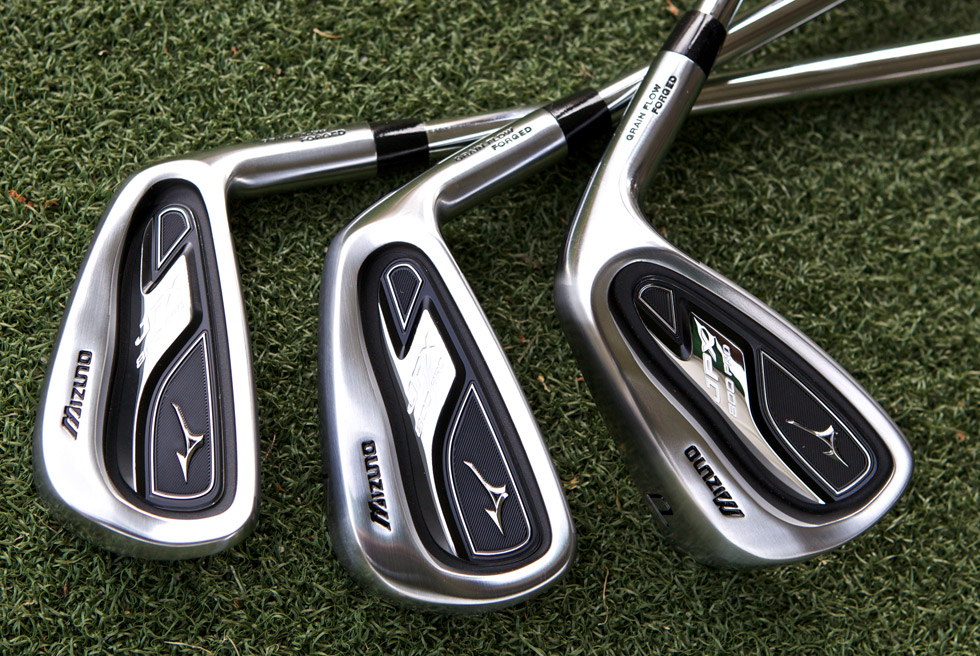
With that in mind, I gladly accepted the JPX-800 Pros with open arms. Based off of the coverage a few weeks back, they seemed to be aimed directly at the game improvement category, whereas the MX-300 was released with the intention of blurring the line between players iron and game improvement iron. That statement was nowhere to be found in the JPX-800 press release from Mizuno. That’s good. Like I said, I could use a little extra forgiveness right now. Turns out, I couldn’t have asked for a better balance.
Though I probably don’t have to say it, good, on target contact feels exquisite, I mean absolutely exceptional. There were a number of shots I hit that I just couldn’t shut up about. However there were a number of other shots where I was making contact out near the toe. I mean, they were absolutely horrible swings. The thing about the JPX-800 Pro is that, yes, it let me know I hit a bad shot – there’s no doubt about that, but it wasn’t an overly harsh, painful feedback. On shots where I was slightly off center, I could feel a slight difference, though probably equivalent to a whisper, where the extreme toe contact was more along the lines of talking as loud as you can without screaming. It’s like a subtle nudge – you know contact wasn’t perfect, but your hands aren’t punished.
The great thing about it is that your score isn’t punished in that situation either. Nearly everything simply flies off the face, with the exception of course being those extreme misses. The consistency of distance on contact across a wide portion of the face is truly exceptional.
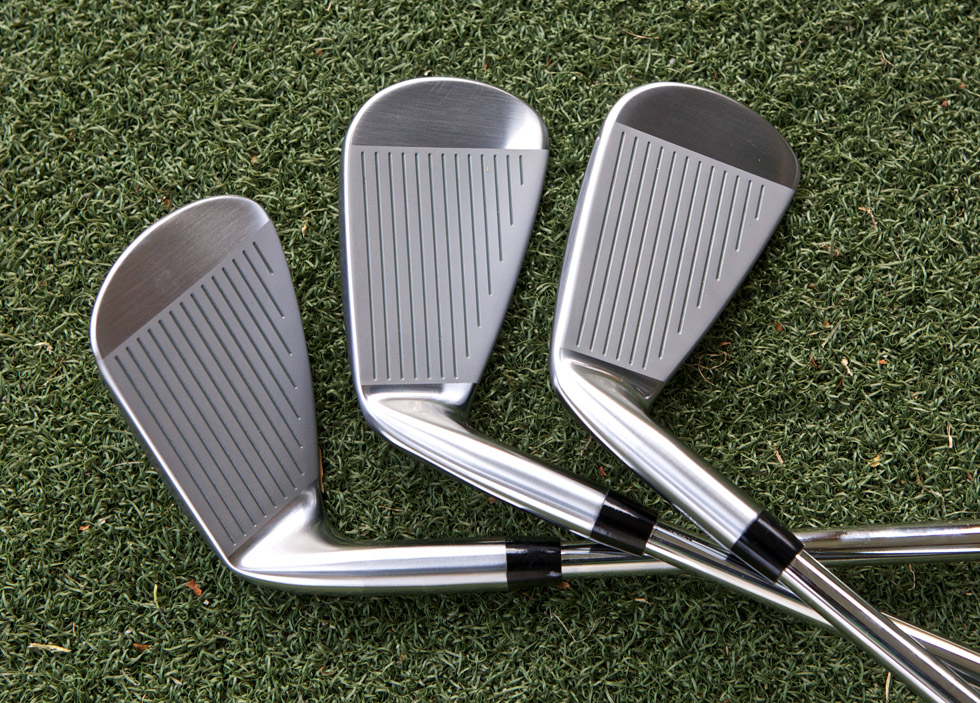
In fact, the distance these irons achieve is nothing short of spectacular. For me, it was actually too good in my first round with them. I actually over shot a couple of targets, though after a couple more rounds with these in the bag, and becoming more familiar with them, and that problem no longer exists. What a great problem to have though, right? Dialing in those three quarters and half shots will also take a little work, with a little more touch on my part as well. In this case I suspect my rustiness was the majority of the issue there. Give it a solid swing, and solid contact, and you’ll get exactly what you want in return. One big observation is that even though the distance these irons produce is great, I didn’t find that they launch the ball ridiculously high. They do get the ball up in the air easily, but a lot of the game improvement irons I’ve hit really take the ball insanely high in the air in an effort to go longer. That’s not the case here. Ball flight is penetrating and boring and is pretty workable up and down. Some irons I’ve hit have made it nearly impossible to go low, but the JPX-800 Pro does not fall into that category. I was ecstatic with one particular pitching wedge shot that I had to keep low. The flight was actually lower than I had intended – so low that I thought it would skip off the back of the green, but instead it landed, bounced once, and immediately checked up. I couldn’t have been happier to leave the wedge in the bag on that trip to the putting green. Overall I was pretty surprised with that aspect, as the Dynalite Gold XP is listed as a high launch shaft.
Steering the ball left or right wasn’t all that hard either. At only one time did I not get my desired result in drawing a ball around a tree, but again, this being the lone exception leads me to believe it was my rustiness, not the club. Other than that one instance, the JPX-800 Pros were like mind readers.
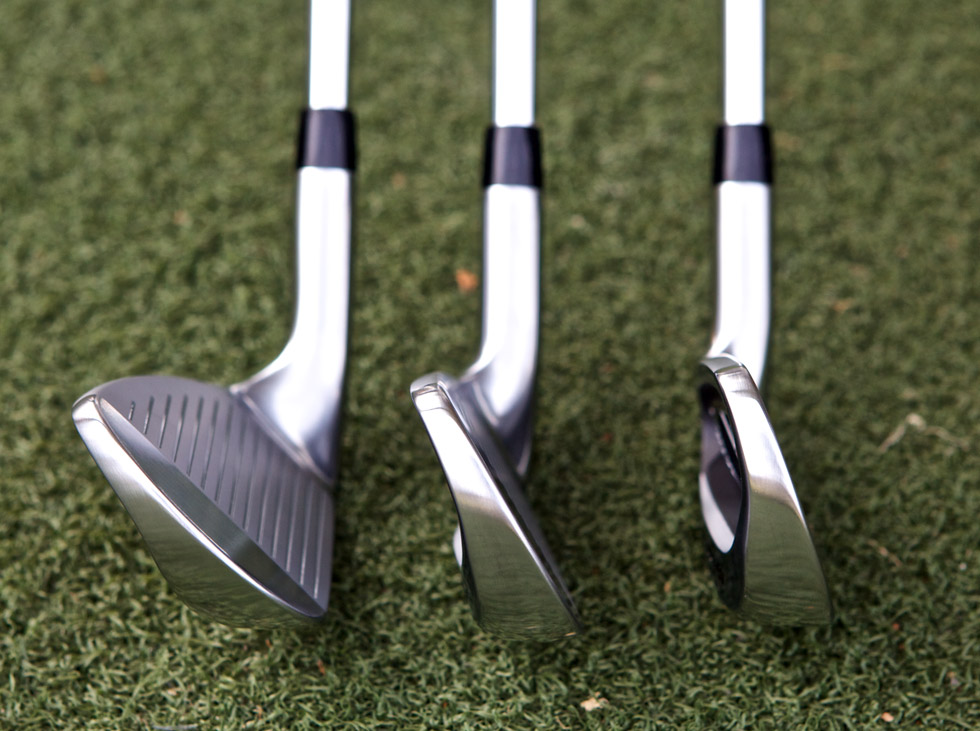
When I was able to find the rough, I was extremely happy to discover that the JPX-800 Pro does a great job of getting the ball out without very much effort. I especially liked its performance on a sidehill rough lie. It cut through the grass without any premature twisting of the club face due to longer grass, and the end result were shots straight down my target line. Of course I compensated as well as possible for the ball being above or below my feet, but still, the club cut through the higher grass beautifully. Never at any point did I feel like it dug into the ground excessively either. Instead, it slipped smoothly through the turf after contact and released perfectly.
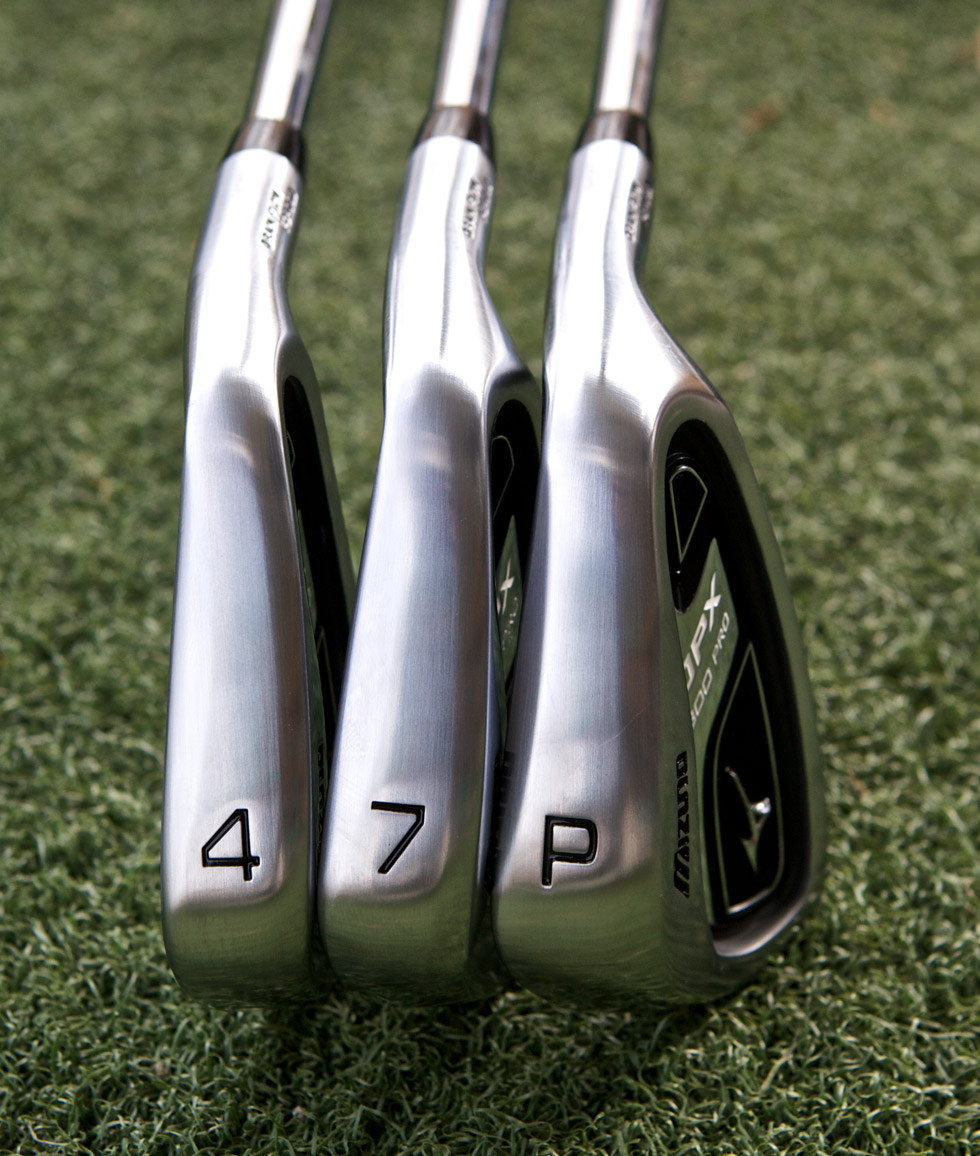
Back to the Dynalite Gold XP shaft for a sec. I think this shaft is a great match for this iron. I’m used to the Dynamic Gold S300, which weighs considerably more, and I could definitely feel the difference in weight throughout my swing. That was a good thing though – I liked the lighter feel and at this point in time, and I thought it gave me a little more control and consistency over a couple of others I hit side by side with the JPX-800 Pro.
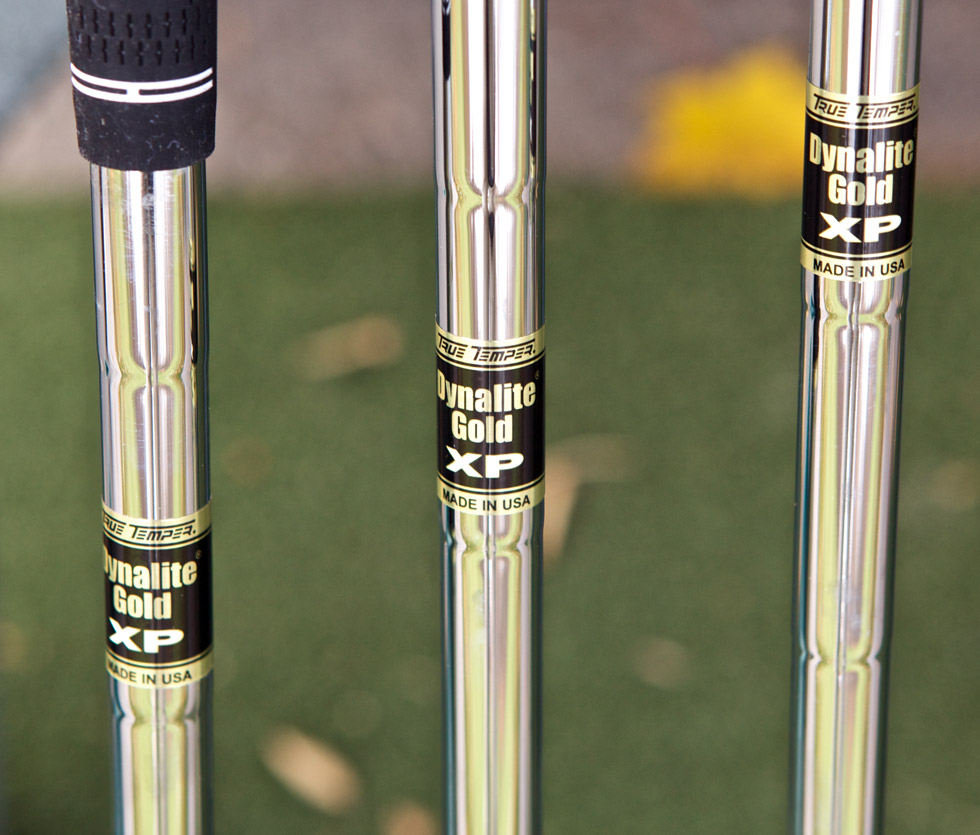
Specifications
The JPX-800 Pro comes equipped with the True Temper Dynalite Gold XP shaft either in R300 or S300, and is an excellent choice of a stock shaft. The Dynalite Gold XP weighs in at 10 grams lighter than the standard Dynamic Gold, and also produces a high ball flight. This is going to help players in a few different areas. First off, the lighter weight is going to lead to less fatigue, and is going to help the player get the club around faster. The high ball flight is going to lead to longer distances and make it more likely for the ball to stick when it lands. Topping it all off is the Mizuno/Golf Pride M-21 58 Round rubber grip.
Mizuno Custom Shop set them up with the specs I needed (+1.5″ long, 2° upright). Keep in mind that there is a half-inch to quarter inch difference in the standard length of Mizuno’s irons compared to some other manufacturers.
If the Dynalite Gold shaft isn’t your thing, Mizuno offers a wide variety of other shaft options or if it’s another grip you desire, they have a number of other grips available as well. A list of those can be found here (shafts) and here (grips). Or maybe you’re like me, and just need some adjustment to lie and length. Either way, a call to Mizuno Custom can take care of whatever you need.
Standard Specs:
Club Loft Length Lie Bounce Offset ---- ---- ------ --- ------ ------ 3I 20° 38.75" 59.5° 1° 0.171 4I 23° 38.25" 60.0° 2° 0.161 5I 26° 37.75" 60.5° 2° 0.154 6I 29° 37.25" 61.0° 2° 0.146 7I 33° 36.75" 61.5° 3° 0.134 8I 37° 36.25" 62.0° 4° 0.122 9I 41° 35.75" 62.5° 5° 0.110 PW 45° 35.50" 63.0° 6° 0.102 GW 50° 35.25" 63.0° 7° 0.102
Conclusion
Can I say enough about the JPX-800 Pro? Nah, probably not. They’re a near perfect combination of what one would want in a game improvement iron- forgiving yet moderately workable, compact and very attractive. I can easily see better, lower handicap players with the JPX-800 Pro in the bag, yet I can also see someone on the low end of the high handicap range playing them as well.
While Mizuno gets a ton of praise for their players irons, they deserve just as much for what they offer in the GI category. This is the second set of irons I’ve reviewed in that classification, and I gotta be honest, they blow just about anything else I’ve hit out of the water. They’re as easy to hit as a lot of the much bigger, max GI irons out there, yet you look down at them, and they appear only slightly thicker than a blade.
There’s no doubt the JPX-800 Pros will be in my bag for quite a while, and I firmly believe that, if you’re in the market for new irons and you don’t try these out, you’ll be selling yourself short. Mizuno absolutely has a winner on their hands with the JPX-800 Pro irons.
Review is spot on. Just purchased mine with Nippon 950GH Regulars. Had the Mizuno grips replaced with Winn Lites and went right to driving range after I picked them up. Am also a MX300 owner with same shafts and same grips but I gotta say the review is spot on. The JPX800 Pro doesn’t “look” as forgiving as the 300’s as the cavity seems to not buldge as much, but they are from my hour on the range A LOT more forgiving. I am a natuarl fader but now my balls really and truly seem to have straigtened out. I don’t work any ball I just want it to go striagt where I’m aiming and these seem to do the trick.
I’d really like a review on the Burner 2.0, since it is the natural and probably one of the nearest competitors to the JPX 800 PRO / and even more so, the JPX 800 clubs. Burner 2.0 is probably one of the longest irons out there, but sure would be nice to have your view on the playability and feel, and the total package. So. Please consider making a article on the Taylor Made Burner 2.0 irons.
I agree 100% with this review. I have owned these clubs since they came out and have mine with KBS tour shafts. For me these shafts make these iron heads feel even better. I had been searching for a forged cavity back that that offers forgiveness yet provides great feedback and a reward in “:feel” for pured shots. It was a challenge as forgiveness and feel are diametrically opposed. Mizuno has figured out a way to do this with the JPX 800 pros. I think these are likely going to be sleepers though and many people may not gravitate towards them since they are not marketed like Burners or the RAZR’s that are coming out. That is unfortunate for them as these irons offer it all. They are long, forgiving, have Mizuno feel and look great. My search is over and these will likely be in the bag more a long time. Now to find a new driver…
just got a set of jpx800 with graphite.gw,pw ,9 are great. backs of 7,6,5 visible at address .will comment further when i have tried them all out
As usual, excellent review. If possible, could you please review their new JPX-800 driver?
Justin, now that the 800 Pro is in your rotation, is the MX300 no longer in the rotation? I have the MX300 and love them but your article would suggest we try the 800 Pro instead
Dennis,
The MX-300s still see their fair share of time, probably a little more lately since I’ve been playing more. The main reason I say that is because the MX-300s have the TTDG S300 shafts, as opposed to the JPX-800 Pro which has the TT Dynalite Gold shafts. I wasn’t playing quite as much (and not in as good of shape) when I reviewed the JPX’s, so the lighter Dynalite was working better for me then, but now it’s back the S300. As much as I love the JPX-800 Pro, I’d have a hard time telling you it’s worth making the switch, but don’t take that as a knock agains them. It’s more because the MX-300 was that good, and I’m not sure there is enough difference from a performance standpoint to justify spending the money if you already own the MX-300.
Now, if someone were in the market for a new set of irons, and didn’t have a similarly performing set from last year, I’d absolutely say try the JPX-800 Pro because they are an all-around great iron.
Justin, I’m currently hitting the older Nike Pro Combo Tour irons and wanted to upgrade to a newer club. My higher handicap is more a reflection of my short game rather than my ball striking. I love my nikes but they aren’t very forgiving. I was thinking of getting the MX300 since reading your review last year but then they went out of production. I too play the TTDG S300 shafts. Would you recommend the JPX800 pro over the MX 300 even though I can get the MX300 for half the price? How do the top lines compare? I grew up playing blades (as did all us older players) so I can’t seem to hit clunky looking clubs with large top lines. Looking forward to your reply and hopefully playing a club with a little more forgiveness.
Hey kseam,
If you can get a set of MX-300s for half the price you’d pay for a set of JPX-800 Pros, I’d have to say that you should pull the trigger on that deal. Like I said in my reply to Dennis, that is in no means a knock against the JPX-800 Pro at all, I’ve got nothing but good things to say about them, but a better deal is a better deal, and in this case, there isn’t enough difference between the two sets to justify spending that much more money.
As for your second question, the top lines look identical between the two, if there’s any difference in thickness I can’t notice it. To give you an idea of the top line thickness, it’s very close to that of the Nike VR Split Cavity, which I’m guessing is close to that of the mid-irons in your Pro Combo Tour set. I couldn’t find any pics to verify that, though, that’s just my best guess.
Hope this helps, and if you have any other questions, please feel free to ask, I know it’s a tough decision 🙂
Justin,
First off, this was a great review. I just went with the JPX-800 pro irons after trying EVERY iron that I could think of at a large demo day that featured every major manufacturer. I have been playing a set of Callaway Fusion Irons that I purchased new in Jan,2005. I’d say the Fusions biggest plus was they are long and forgiving, but the titanium face dont give much feedback and you dont get that sweet wow feeling on a great hit, and the uniflex shaft would balloon my short iron shots. I went to the Callaway tent first off to hit the Diablo forged and they felt and sounded really good but I was pretty concerned about the ballooning that I felt I would get with my short irons with the uniflex shaft. I expressed my concerns to the callaway “rep/celebrity”, I told her I wanted a shaft that would help get the ball in the air with my longer and mid irons but not balloon my short iron shots. She didnt recommend any other shaft and maybe she was just too busy so I moved on. My next stop was the Mizuno tent. I have to admit I didnt really think that Mizuno would have a club for me. I just assumed that Mizuno was a “players” club. I told the Mizuno rep that I was looking for a game improvement iron and he handed me a MX-1000. I hit it and it was a good hitting club, BUT,… it was big and chunky and no feedback. I then asked if he had anything else and he handed me a JPX-800 and it looked much better and I hit it really well, but it wasnt quite what I was looking for. He then handed me a JPX-800 pro and he would watch me hit a few balls and would then ask for feedback and would then swap shafts and then watch some more and in the end I quickly feel in love with the JPX-800 pro’s. They felt soooo sweet on good contact and would let ya know when your contact wasnt as good. I was surprised that the distance was pretty much the same as my Fusions. I expected to sacrifice distance for feel and good ball flight. It still confuses me how these JPX-800 pro’s can be just as long as the Fusions which are supposed to be a distance iron, and my Fusions are 1/2″ longer. In the end, “my” shaft was the TT Dynalite Gold XP S300. The rep assured me that my ball flight would be consistant throughout my set, and that I wouldnt get the ballooning effect that I do with my uniflex shafts. I then hit a few more balls with “my” setup JPX-800 pro’s and with every shot I hit I feel more in love with them. I then decided to give the other different manufacturers a try. I tried the Cobras, Cleveland, Nike, Adams and even Taylormade and I couldnt find anything that fit my “game”,… or actually my lack of game more than the Callaway Diablo Forged irons or the Mizuno JPX-800 pro irons. After trying everything else I went back to the Mizuno tent and had them perform a complete fitting on me for the JPX-800 pro irons. I then went to the local retailer tent that was present and placed my order. I’m now like a kid waiting on Santa to arrive.
Hey Shaggy,
Thanks for the compliment, and I’m glad to hear you had a great experience!
Justin,
Well,…. my JPX-800 pro’s arrived today and I couldnt wait to take them to the range. Honestly, I was wandering in the back of my mind if I had chosen the right set of irons since all I hit was a 6 iron during the fitting process. I then arrived at the range and started with the pitching wedge and each shot fired off the face and felt wonderful on impact. I then would hit several shots with each iron as I worked myself up through the set. I have to echo your comments of the feel and distance of these irons. I could tell when I was right in the sweet spot and I also definately knew when I was way off as well.While at the range I would see my ball would land at what appeared longer than my usual distance, but I didnt think much of it since I was just working more on contact. After hitting several balls with each club I was feeling I had made a great choice and was feeling great about my new irons.
Then a buddy showed up and asked me to play 9 holes with him. I was just so shocked at how much more distance I was getting with the new pro’s. After I overshot the green on 3 different approach shots I started grabbing a shorter iron than I usually did.
It’s just funny at how close your review of these clubs was similar to my experience.
Justin,
All things being equal(price, shaft, etc.), would you choose MX-300 or JPX 800 Pro?
Thank you the excellent reviews of both clubs.
Great review. While demo hitting Adams A12 and CB2’s, my buddy talked me into trying these JPX-800 Pro’s. OMG. Every shot felt like sweet spot city. Numbers looked awesome. Never felt shots that felt like these. I’m not that good and every shot felt awesome.
Went home, read reviews including yours, and returned the next day. Used their fitter to select shaft (XP Stiff). Bought a short set — 7 through PW. I’ll see if I want a GW. Keeping my 5 and 6 iron from my current set until I see distances and what I might need between 7 iron and current 4 hybrid.
Current irons are same as Shaggy’s — 2005 Fusions with DG S300 shafts.
Still waiting for delivery from Mizuno through Golfsmith. I ordered .5″ long and 1* flat. That 1* flat was from my teacher when I was fitted by him for my Fusions in 2005 (based on my size and how I SHOULD swing). I did some digging and find that the JPX-800 Pros are already much flatter than my Fusions and any current Callaways. So, Golfsmith and I are trying to change the order while it is process. Not sure how that is going to work.
Question are:
1. Since Mizuno are flat, should I order by lie number or is there a reason they should be different than my old clubs? For example, standard Mizuno 7 iron is already 1* flat compared to the standard Fusions. But they become even fatter through the set until the 9 and PW standard Mizuno is 2* flatter than the standard Fusions.
2. Is there a reason these “better player” irons get flatter as you drop down through the set?
After my first 1.5 hours of practice with these clubs this morning, I’m in love. Swing great — just the right weight with the XP S300 shafts. Ball flight lower than Fusions (I wanted lower) but still high by most standards. Can hit it low easily. Pure shots are awesome. Seem almost half a club longer than the fusions but hard to tell how much since the wind was way up. I did not notice the 1* extra flat compared to my 2005 Fusions — even head to head. They are not magic. Really bad swings swings result in really bad shots. Good swings feel great. And great swings are a rush.
i have had a hit with the JPX800 Pro at a demo day recently and really did like the feel of them in (in combination with a NS Pro 950 shaft).
I have been given what seems like a decent price on a set, but whilst researching i am now caught between them and a new set of MX300’s with the same shaft for about $200 cheaper.
Are the JPX’s worth paying the extra for, or is the difference that minimal I should try and save a few dollars?
Opinions are appreciated, thanks guys.
New to the site and wanted to comment on the 800 Pro. Played the MP 30’s for years and left the game for a while. Got back into playing about 4 years ago with a set of MX 23 (always have been a Mizuno fan). I never hit them as well as MP. Demo’d the 800 Pro in June and decided to make the jump. I was fitted with 1/2″ over standard length and moved from stiff to reg shaft. (Dynalite XP stock). Getting older!!! What a club! Have played 20 + rounds with them and still can’t believe the difference. Everyone talks about distance gained. These are same specs as MX 23 yet a full club longer. I had to purchase the gap wedge to fill in between the PW and 54*. Club is very easy to hit out of rough and produces a high ball flight. With the MX’s my typical ball flight was straight or slight draw. With the 800 Pro my ball flight is a touch of a cut. I assume it is the difference between the shafts – also moved from 2* upright to standard. Overall, I could not be happier. Great looking at address and produces a consistence ball flight and VERY Long. The new JPX wedges are a great add on to the set. I have the 54* and trying to decide between the 58* or the R12. Either way can’t go work with Mizuno thanks
I was at Golfsmith this afternoon. I was ready to make the forge upgrade from my TM R7s. I hit several forged clubs; PING Anser, CB2 Adams, TaylorMade MC, and I think one more that doesn’t come mind right now.
I quickly narrowed it down to two: Ping and the CB2. I loved the way the Ping felt but found I could work the ball better with the CB2 which had less feel–but not by much. I asked the GS Rep if I was missing a club from my selection. He said I needed to try the Mizuno JPX-800 Pro. He left to get one.
When he was gone, I thought about Mizuno as a brand. A friend of mine got a set in the late ’90s for Christmas and knew he was getting them ahead of time. He was a serious Christmas morning child. And had spontaneous Mizuno outbursts at random. He loved his Mizunos. I always seem to relate my old friend to Mizuno because of that story. I’d take a Mizuno demo club out of the bin now and again, but never felt it. About this time, the GS Rep arrived with the a JPX-800 pro 6i.
The first swing I shot in the simulator with that Mizuno 6i was the best shot I had.of all the clubs I tried. It registered at 217 yds. My jaw dropped (literally)! The feel, the sound was beautiful. I worked the ball well but had a little trouble with my fade, definitely not the clubs fault.
I made the purchase hoping I could find some degree of success on the course. After driving off the #1 tee box, I left myself with about 195 yards to the flag. I pulled the 4i. The first shot went left and short about 100 yards from the flag–mishits. I took a provisional, made an adjustment and took a practice swing this time, and hit a baby-draw just two feet from the green.
The feel and sound brought a smile to my face. With no one was behind me, so I decided to play both balls. I used my GW. Same feel/sound and rested the ball next to the other ball.
My R7s, that I’ve had for more than a couple of years now, were not even close to this exciting. I wasn’t keeping score, but I shot better. Even my mishits felt good. I can already draw the ball consistently with my 4i and 9i without going to the driving range.
The sum: these JPX-800 Pros are serious clubs. I can only imagine how much my game will improve practicing with these clubs over the coming years. Mizuno has pleasantly surprised me. I can finally identify with my old friend with this brand. I think I am a fan for life.
Just got these last weekend to replace my beloved MP-57s. The JPX-800 Pros are about a club longer (as you’d expect given that the lofts are 3° stronger), and it’s a bit harder to hit a bad shot with them. I had three birdie chances on the first 4 holes, which means I either drank the magic Kool-Aid or the JPX-800 Pros are easy to hit accurately.
Feel-wise, you lose a little feedback. My great shots did not have that instant “oh, yes, that was perfect” feeling — they ended up where I wanted them to, but I didn’t know immediately that they were going to be good. Bad shots, yeah, you can hit some hand-stingers with these, but you have to put a real bad swing on it.
As far as looks go, judge for yourself. I think they all look fantastic except for the P-wedge and G-wedge, which look a bit like a chubby kids. I’m swapping them out for blade wedges this weekend, just because I can’t get comfortable over them.
I think these might be keepers.